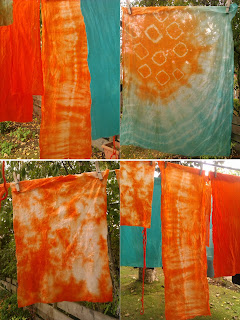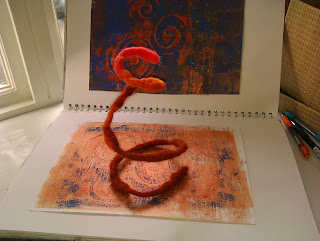I haven't been entirely idle in terms of Distant Stitch work, but I've been working a bit piecemeal, a bit of this, a bit of that.
However, I felt I needed to get into the habit of posting on my blog again, so here is what I've done so far.
I have already posted some hand stitching that I did, but I've added more stitching to some samples so will include them again in this post.
Colouring Fabric
I was beginning to run out of coloured fabric and so had another go at that. Last time I saved time by using fabric paint and acrylics mixed with fabric medium, but I thought I'd like to revisit some shibori from Module 2. I used Dylon cold water dyes in sea blue and goldfish orange and a mixture of muslin, plain white cotton, calico and felt.
 |
| 3.3.d1 the fabric prepared for dyeing |
 |
| 3.3.d2: the blue dyebath |
 |
| 3.3.d3: the orange fabrics rinsed |
 |
| 3.3.d4 some of the results drying on the line |
Stitching on fabric
I have really enjoyed the hand-stitching. Armed with Mary Thomas's Dictionary of Embroidery Stitches I spent some blissful hours (on the comfortable sofa in my newly refurbished studio!) enjoying the meditative rhythm of hand sewing.
 |
| 3.4.h1 |
 |
| 3.4.h2 |
 |
| 3.4.h3 |
I had a fragment of fabric, left over from Summer School, which I had monoprinted and didn't much like as I thought the grid was too regimented. I had attempted to make it more interesting by printing spirals with a print block, echoing the grid idea, but with the curve of the spirals to soften it. I used a different stitch for each spiral so making it less symmetrical. Again this was most enjoyable to do.
 |
| 3.4.m1 |
Playing with spirals
A bit of fun. I printed some spiral digital artwork onto Tyvek and cut out some spiral shapes before ironing them between sheets of baking parchment. The pieces resulting reminded me of some strange sea creatures and so I stitched them onto blue cotton. I wanted some of them to be concave rather than convex and so coloured the white side with acrylic paints. I am considering whether I should leave this piece like that or stitch on some wave shapes, either by hand or machine, around the creatures.
 |
| 3.4.p1 |
Inspired by Sian's Murmurations piece and by a new book I bought, "500 Felt Objects", I covered some wire with fleece and wet felted it before bending it into a spiral shape. It can be bent into any shape and this might be the germ of an idea for later in this Module.

















































